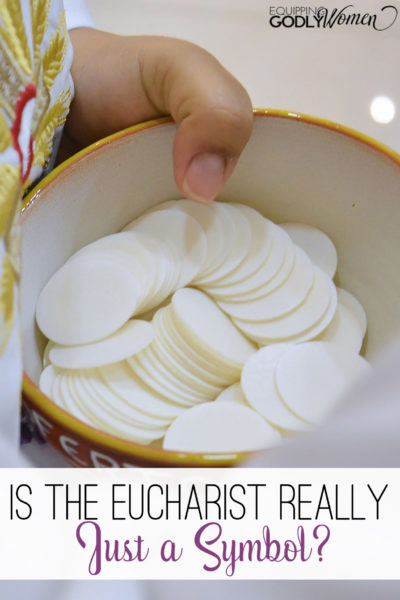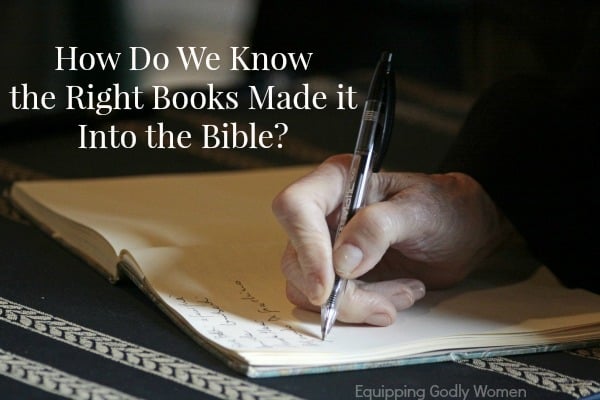Is the Eucharist Really Just a Symbol? 5 Convincing Proofs that Say that It’s Not
This post is post 3 in a series entitled Letting God Lead: My Journey Through Protestant and Catholic Beliefs. While you certainly can read this post by itself, I highly encourage you to check out the rest of the series as well. Find more about this series and a list of all of posts here. This post contains affiliate links.
The first blow to my old Protestant belief system was a big one, and one I wasn’t expecting. As I was reading along in the book Surprised by Truth, one section jumped right off the page and stopped me right in my tracks:
“Writing to the church at Smyrna, a major Christian center in Asia Minor, Ignatius condemned heretics who denied that Christ had an actual physical body… To refute them, Ignatius wrote “They [the heretics] even absent themselves from the Eucharist and public prayers [cf. Acts 2:42], because they will not admit that the Eucharist is the flesh of our Savior Jesus Christ which suffered for our sins and which the Father in his goodness afterwards raised up again.”
Now, I’d had Catholics tell me that Jesus’s words “This is my body” and “This is my blood” were literal before, but not one of them could ever give me a single solid reason why I should believe it other than because that’s what they *thought* the words meant. Well… that’s not a very good argument. They thought it meant one thing–I thought it meant another. So… not exactly convincing.
You see, Jesus spoke in parables all the time, I reasoned. Therefore, the most logical conclusion was that this was simply another metaphor too. Just like how he said he was the vine and the door. Metaphors.
Except that once I started researching further, I started to discover things I never knew before. And in the course of my research, I found five very convincing reasons why the Eucharist must be none other than the real body and blood. Maybe they’ll convince you too?
[thrive_leads id=’23166′]
1. The Early Church Believed It
I’ve always thought that if anyone had a chance of getting it right, it was the early church. After all, they were the ones who heard it straight from the source.
Take Ignatius, for example (author of the quote above). Ignatius was the first bishop of Antioch (the city were Jesus’ followers were first called Christians) and he studied under the apostle John (the one that wrote the Gospel of John). I’d say he would probably be a pretty reliable source! And yet, here he was writing about the real presence of the Eucharist as though it were common knowledge only 10 to 15 years after the apostle John’s death! That’s not a lot of time to get the message mixed up.
You don’t just have to take his word for it though. Apparently all of the early church fathers believed in the real presence of the Lord in the Eucharist. In fact, the doctrine was never seriously questioned until the 11th century. Hmmm…. Did not know that.
Given the choice between what my pastor says today and the beliefs of the first (and second, and third…) century church… well that’s a pretty strong argument. And it’s not the only one.
2. The Jews Couldn’t Accept It
Another thing I never realized: The “this is my body… this is my blood” passage you read in Luke… it isn’t the only time when Jesus talks about being the bread of life.
I won’t retype the entire passage here, but I strongly encourage you to look up and read John 6:22-71 (link for your convenience). In it, Jesus has a lengthy discussion with the Jews in which he compares the manna the Israelites ate in the desert and the bread of eternal life that God offers today. The Jews are understandably very confused, but Jesus just keeps repeating the same thing over and over again.
“Jesus said to them, “I am the bread of life; whoever comes to me will never hunger, and whoever believes in me will never thirst.” –John 6:33
“I am the bread of life. Your ancestors ate the manna in the desert, but they died; this is the bread that comes down from heaven so that one may eat it and not die. I am the living bread that came down from heaven; whoever eats this bread will live forever; and the bread that I will give is my flesh for the life of the world.” –John 6:48-51
“Jesus said to them, ‘Amen, amen, I say to you, unless you eat the flesh of the Son of Man and drink his blood, you do not have life within you. Whoever eats my flesh and drinks my blood has eternal life, and I will raise him on the last day. For my flesh is true food, and my blood is true drink. Whoever eats my flesh and drinks my blood remains in me and I in him.'” –John 6:53-56.
But where it REALLY gets interesting is the Jews’ reaction after the fact. In verse 66, it records that “many [of] his disciples returned to their former way of life and no longer accompanied him.” Would they leave over a mere symbol? Seems doubtful. So I’m guessing that the Jewish people knew Jesus was being literal, even if they didn’t really understand it.
3. Jesus’s Use of the Greek Word “Trogon”
While having the ability to read the Bible in English is wonderful; it does come with some limitations. One of which is the fact that some things are lost in translation.
What you DON’T notice when reading the passage above is that when Jesus talks about eating, he is actually using two separate verbs. At first, he uses the Greek word “phagon” which is the normal Greek word for “to eat.” Part way through the passage, however, he suddenly switches to the word “trogon,” which literally means to crunch or gnaw.
Jesus wasn’t telling them to “partake” or “consume.” He was saying they literally had to crunch, gnaw or chew. (Kind of hard to “crunch” on a symbol… but you can try!) Furthermore, the tense of the word “trogon” implies that this is an action that will take place continuously over time–not as a one-time event.
4. The Eucharist Comes with a Strong Warning
Fast forward to 1 Corinthians, and you’ll find this strongly worded passage:
“Therefore, whoever eats the bread or drinks the cup of the Lord unworthily will have to answer for the body and blood of the Lord… For anyone who eats and drinks without discerning the body, eats and drinks judgement on himself. That is why many among you are ill and infirm, and a considerable number are dying.” –1 Corinthians 11:27, 29-30
Since when do mere symbols come with death penalties?
5. Eucharistic Miracles
Before a few weeks ago, I never even knew there was such a thing as Eucharistic miracles. At first I was very skeptical–because how could you even prove something like this? But from what I can tell at least SOME of the miracles are VERY well documented, scientific and hard to dispute.
This video on the Eucharistic Miracle of Lanciano was my favorite by far. It’s not gross (Some of them are gross! Is it bad to say that?), but it is based on science and facts, and it’s really interesting!!
https://www.youtube.com/watch?v=WeIz4UGI_Zc
Well, there you have it, folks. These aren’t the only reasons–I actually came up with a few more–but if you believe in the Bible and these arguments don’t convince you (or at least cause you to question!), then I don’t know what will!
And now to answer a few of the burning questions you’ve been asking…
What do Catholics Believe About the Holy Eucharist?
In brief:
- The Holy Eucharist is the real body and blood of Jesus Christ in substance, even though still unleavened bread and wine in appearance. This is called “transubstantiation.”
- The elements become the body and blood at the moment when the priest says the words “This is my body” *poof!* and “This is my blood” *poof!*
- They stay the real body and blood as long as they keep their same form. (Once you digest them, they aren’t anymore.)
- Taking the Eucharist offers forgiveness for minor (venial) sins, but not major (mortal) sins. If you are in a state of mortal sin, you should not take the Eucharist until after you go to confession. (Venial/Mortal sins and confession are all topics for another day)
- Jesus is wholly present in equal amounts whether you have one speck of either the unleavened bread OR the wine or if you have a huge helping of both. Same amount of Jesus. (See the video above. That was awesome.)
Why Can’t Protestants Take Part in the Eucharist in a Catholic Church?
At Protestant churches, all Christians are welcome to receive the communion, yet at Catholic churches, only Catholics can. Why is that?
Well, contrary to popular belief, Catholics aren’t discriminating against non-Catholics. Instead, the main reason is that Catholics recognize the Eucharist as the true body and blood, and so they don’t just hand it out to people who don’t believe in it or who might treat it without the reverence and respect that it deserves.
Most Protestants do not believe that the Eucharist is the true body and blood–but only a symbol–and so for a Protestant to take the Eucharist without believing in it would be considered eating without discerning–a very serious offense according to 1 Corinthians 11:29.
Secondly, according to 1 Corinthians 11:16-17, everyone who participates does so in fellowship as part of a whole, unified community. (Catholics do not believe mass happens at individual churches, but that there is ONE mass in Heaven and by receiving on Earth, they are participating in the Heavenly mass with God and the angels.) While Catholics would love to welcome Protestants to the table, it would imply a unity that isn’t really there. (Not my rule. Don’t look at me.)
And finally–not all Catholics can participate in the Eucharist either. In order to partake, Catholics and non-Catholics have to be in a state of grace, have to have gone to confessions since their last mortal sin, and some other stuff. Protestants (and many Catholics) don’t meet these guidelines.
So… for those of you who were asking–these are the official reasons. And you should probably go check out these two articles which can explain it much better than I can:
Who Can Receive Communion on Catholic.com
Why Can’t Non-Catholics Take Communion on CatholicBridge.com
So I hope that helps?
Conclusion
I know that the Eucharist is strange and doesn’t make a lot of sense. But honestly, much of Christianity doesn’t make sense when you look at it from a purely logical perspective. (Three persons in one? There has to be blood shed for our sins?) That’s why it takes faith.
But–thankfully for people who need logic too (like me)–it isn’t JUST faith. There are very convincing reasons to believe in it too. And these are my five.
Discussion time! Do you believe the Eucharist is the real body and blood? Why or why not? What questions or concerns do you have?

Enjoyed this post? Don’t miss the rest of the posts in the series!
The Day I Realized My Religion Got it Wrong
10 Common Catholic Church Myths that Critics Believe
Is the Eucharist Really Just a Symbol?
Who has the Ultimate Authority? A Biblical Look at Sola Scriptura
A Brief Look at the History of Christianity
What All Christians Should Know About Priests, the Pope and Confession
What Do Catholics Really Believe About Mary, Saints and Statues?
Infant Baptism or Believer’s Baptism? Which is Correct?
What is Purgatory? What are Indulgences?
Why Do Catholics….? Honest Answers to Your Burning Questions
Protestant and Catholic Beliefs Series Conclusion
Resources
I’m not asking you to believe because I say so. Please DON’T take my word for it! The purpose of this series is only to share what I’ve learned on my journey in order to inspire you to begin a journey of your own. Here are a few helpful resources to get you started.
*This post contains affiliate links, which means if you make a purchase, I may make a small commission at no additional cost to you. Thank you!
Catechism of the Catholic Church
Surprised by Truth: 11 Converts Give Biblical and Historical Reasons for Becoming Catholic by Patrick Madrid
A Concise History of the Catholic Church by Thomas Bokenkotter
What Catholics Believe about John 6 by Tim Staples
Two Minute Answers to Your Questions About the Catholic Faith by CatholicsComeHome.org
Who Can Receive Communion by Robert H. Brom
Why can’t non-Catholics, Evangelicals and Protestant denominations receive Catholic Communion? by CatholicBridge.com








Thank you for the research! This was definitely educational!
Thanks, Maria! That was my intent 🙂 Do with it what you will–but at least now you know!
For this last semestar I went to religious education for college students, and the topic of the whole semester was Holy Mass. When the priest talked about the Eucharist it was a huge eye opener for me because I really understood it for the first time (I’m 22 and I was raised Catholic).
It’s such a complicated subject so a lot of priests don’t talk about it often, because it’s hard to explain.
But he made some great points, some of which you talk about here, all corroborated with quotes from the Bible. When he explained the meaning of Last Supper and connected it to Pesach/Passover we were all blown away, and the whole auditory went silent.
I whish I could share it with you but we live in Croatia and all of his homilies are in Croatian.
If you want I can give you his e-mail and I’m sure he’ll be glad to answer your questions ( he lived in Canada and the US, no language barrier 🙂 )
That sounds really interesting! I think I’m sufficiently convinced for now though, thank you 🙂
“sufficiently convinced”?
You are funny. This Eucharist ‘thing’ grows on you, and sucks a person in like flowers do a bee; the Sweet Love of Jesus.
Beware!
lol. Thanks for the warning!
Could you send me the comments …I have a protestant friend that breaks her own bread in her bedroon as she watches her online church…syas it is between her and God
I’m really enjoying this series, Brittany, and glad you are witnessing to truth as found in scripture and the early Church beliefs. I have two “nuances.” While we believe the miracle of transubstantiation does occur with Christ’s words of Institution, saying “poof” makes it sound a little like a sudden magic act! The Holy Spirit is present at the altar and acting upon the elements of bread and wine from the beginning of the Eucharistic prayer. And while it is true that Christ’s body and blood (and soul and divinity) are present as long as the appearance of bread and wine remain, when we consume Him in this way, WE become the form of Christ. He “abides in us and we in him” (John 6:56). So his presence is not LOST by digestion, but made intimately personal. As Paul says, “it is not I who live, but Christ who lives in me.” (Gal 2:20). God bless your journey!
lol at the first one. It kind of IS magic! (Not the sorcery kind, but the miracle kind)
And the second one–yes. Thanks for the clarification. Like I’ve mentioned before, I’m not even Catholic so I’m doing my best! lol 🙂
“I’m not even Catholic so I’m doing my best”???? Truly you are doing MUCH better than that. You are doing a great service of charity to Christ’s Body. Keep it up.
Well, I can’t very well do BETTER than my best, now can I? But thank you. 🙂
Very interesting read!
Thanks, Janell!
Just wanted to share with you how much I’m enjoying this series. My husband and I are both Catholics reverts…and watching you explore this on your blog reminds us of our own journey to strengthening our faith in search for the Truth. Well done.
Thanks! I hope you are learning a lot (or rather, it’d be awesome if you already knew all of this!) and feeling inspired and strengthened 🙂
Hi Brittany,
This series is fascinating, and I love reading it!
I had a question about John 6:33 though — (Jesus said to them, “I am the bread of life; whoever comes to me will never hunger, and whoever believes in me will never thirst.”).
If Jesus is talking about never thirsting and never hungering and we know that’s not literal (because who of us has not ever been hungry or thirsty), how do we know he’s being literal in the rest of the verse? It would seem to me that he would continue his mode of thought from one sentence to the next.
What are your thoughts?
I think that in this part He is not talking about physical hunger and thirst in this life. It means that he gives eternal life in which we’ll never be hungry or thirsty (and free of all other physical needs) by giving us his flesh and blood.If we eat his body we will have eternal life where we will not be hungry or thirsty ever.
Mind that whenever he talked in metaphores He would later explain it to the apostoles, He would clarify it. But here, when his disciples say: “This is a hard teaching. Who can accept it?” “and many disciples left him then” (understandably, because it IS a hard teaching to understand and accept), He didn’t provide further explanations to the Twelve, He said: “You do not want to leave too, do you?” Jesus asked the Twelve.
He was very clear on this. Would he really just let go of his disicples over a missunderstood metaphore?
That is a fantastic question. I have no idea. I can look into it for you, though! Honestly, what it came down to me, though, was after I had researched and looked at both sides, I asked “Looking at this as unbiased as possible, if I’d never heard anything about either side either way and I was trying to figure it out based on the text–which side makes more sense?” And for me, the position that it is real simply had WAY more facts in its favor. We’ll never know 100%, I imagine. But that’s my best guess.
Megan/Brittany,
Definitely not a theologian, but here is my best take. In John 6:27, Jesus instructs us not to work for food the perishes, but for food the endures for eternal life. The people then ask Jesus for a sign saying, “Our ancestors ate manna in the desert, as it is written: He gave them bread from heaven to eat.” Jesus then answers, “Amen, Amen I say to you, it was not Moses that gave the bread from heaven; my Father gives you the true bread from heaven. For the bread of God is that which comes down from heaven; my Father gives you true bread from heaven.” Jesus is the new manna that doesn’t just fulfill our physical hunger like manna, but our spiritual hunger. True sustenance endures for eternal life. So I think Christ is still literal in the sense that we will never hunger and never thirst, but he is referencing our spiritual hunger and spiritual thirst.
Megan,
You hit perfectly the difficulty with the text, that it contains both literal and figurative elements. The Catholic exegesis would say that the switch occurs in the middle of the discourse. Jesus is using symbolic language “I am the bread of life, etc” (He is no more literal bread than he is a literal door). But then he switches “I am the living bread that came down from heaven… and the bread that I will give is my flesh for the life of the world” Since the discourse is given within the context of the feeding of the 5000 with literal bread and fish Jesus is predicting another literal bread that he will give which will be his flesh. Additionally, he then uses very graphic language for eating to emphasize the literal sense of his words.
I understand your confusion, but I offer this for your contemplation.
http://www.miraclesofthesaints.com/2010/10/miracle-of-eucharist-total-fast-from.html
Brittany,
As a “cradle Catholic” I’m enjoying reading your series! You are tackling some big and often misunderstood topics of the Catholic faith with a lot of great information. I can’t imagine all the hard work and hours you are investing to compile such clear and concise posts about various beliefs of the Catholic Church, like the Eucharist. I too love learning about the early church fathers and the Eucharistic miracles are amazing! I know the teaching of the Eucharist is difficult for my limited mind to fully comprehend and that’s why I often say in Mass “I believe, help my unbelief.” Like you said, it takes faith to believe in Jesus’ teachings, but with faith comes much fruitfulness. May God continue to bless you on your journey!
Thanks, Tracy! It IS a lot of hard work and hours, but it’s worth it, right?
Brittany,
Anytime we earnestly seek truth and Gods will for our lives, it’s ALWAYS worth it!
Megan, Jesus can be interpreted literally here. Assuming I’m properly disposed to receive Him, the Eucharist is completely restorative and eternal. Any spiritual hunger or thirst is fully sated at Communion, and if I died that evening I may never have hungered or thirsted again! Unfortunately, by that time I may have chosen to retreat back into sins both great and small, so my new spiritual hunger and thirst is not because Jesus has not filled me completely and permanently, but because I am a very imperfect vessel full of holes. His grace would “be sufficient” (2 Cor 12:9) if I didn’t squander it. Which is why the Church is necessary, a fountain of grace through the Sacraments of Reconciliation and Eucharist.
Brittany I know you’ve put a great deal of research into this.
My concern is that the transubstantiation was decreed by a man, Pope Innocent III in 1215. It was not Jesus who The thought that a man can change a mere wafer and drink to Jesus’ physical body and blood is troubling to me. How can we be the creator of the Creator?
We must also look at the Last Supper in context. It was Passover; a time when Jews celebrated God’s saving grace through the shed blood of a lamb painted on their doors. That blood was spilled to save them; now Jesus is saying, “This is my blood, spilled for you.” They would have understood the symbolism because the feast they were celebrating was in remembrance to a time when their people had to shed blood to be saved.
Danielle, you are correct that the word “transubstantiation” was not “decreed” by Christ, but neither was the word “Trinity.” In both cases a theological vocabulary was formed to explain almost-inconceivable truths. We cannot, with our limited intellects, comprehend the fullness of a Triune God, nor can we adequately define and explain HOW Christ can be present in the Eucharist. “Transubstantiation” as a term, and as an explanation, was created by man (not just Pope Innocent, mind you, but over 500 patriarchs and bishops at the 4th Lateran Council backed up by the historical and infallible teaching authority of Christ’s Church). But that doesn’t mean the truth it explains is not valid. The Catholic Church doesn’t “invent” truth, it simply teaches the truth given by Jesus Christ, and strives to explain what that truth reveals about God and salvation through Jesus Christ.
Danielle,
The author is clear above that the early church (long before the 11th century) believed that Jesus’ Body and Blood were truly and fully present, under the *appearances* of bread and wine.
Popes do NOT make up doctrine, nor do they sit in committees to plot out which doctrine they will make up this month — instead they respond to issues. In the 11th century, the question of Christ’s presence in the Eucharist was brought to a very public head, and the Pope responded by explaining/defining in no uncertain terms what the Church had believed up to that point.
Regarding the connection to Passover. God gave the words, rules, articles and gestures for Passover. The Jews were to follow very strict ordinances here. NO changing of the words. God set it forth, only God can change it.
And Jesus changed the words.
No-where in the Passover celebration do we find words about “This is My Body” and “This is the chalice of My Blood”. These words were said in the context of the Passover celebration itself – during the time when the words were to be the same from one year to the next.
Yes, they would have understood the symbolism – and they would have understood the SIGNIFICANCE of what He was saying. Perhaps not fully just yet – that took the power of the Holy Spirit given to them at Pentecost, to fully understand.
And there-in lies the power of transubstantiation. It is not “man” being creator of the Creator – if anyone has that honor, it would be Mary who bore Him in her womb and nursed Him at her breasts. In the Eucharistic Prayers, we “implore (God the Father) by the same Spirit, graciously make Holy these gifts we have brought to you for consecration, that they may become the Body and Blood of Your Son, our Lord, Jesus Christ.”
The Holy Spirit has the power; we humbly request – because Jesus TOLD us to do so.
The question of “How can the Catholic church just DECIDE things years later” was a big one for me too. Thankfully, that’s not what actually happens. Instead, the church simply believes what she believes and then offers a formal decree when teachings are challenged in order to clear up any misconceptions.
For example, I’ve never told my children not to throw our pet down the stairs. Not because they can, but because I’ve never felt the need to. It’s assumed to be common knowledge. If my children were ever to try this or ask if it were okay, however, then I would have to officially tell them no. The church does the same thing. They don’t decree a bunch of things people already know. (“The sky is blue!” “Yes… we know….?”) Instead, they clarify when challenged. I believe that’s what happened here.
And if you look through the early church fathers, you would see that they all believed in it. So it wasn’t just invented later.
Also–I agree that the Jews would have originally thought symbolism. Which is why they were so confused and asked again and again, and why Jesus had to keep repeating the same message again and again, and even using the literal words for “chew.” If they thought it was just a symbol–why would they leave? Their reaction doesn’t make sense in that light.
As someone already said it is not a mere man who transforms the gifts it is the Holy Spirit who does the transforming.
While it is a theological nuance, the bread and wine do not become the “physical” flesh and blood of Christ. (It’s why eating and drinking the Sacrament is not an act of cannibalism). The physical properties of bread and wine still remain unchanged.
Another way to understand the mystery is that the bread and wine, by the Holy Spirit, are perfectly united to the Person of Christ in such a way that what was two realities (bread/wine on the altar on earth and Body/Blood at the altar in heaven) become one reality (Body/Blood on earth and in heaven) without losing their distinctive physical attributes.
You also mention the blood of the Passover. The “blood of the covenant” was not a liquid symbolic of lamb’s blood but was literally the blood of the lamb. The Paschal context would lead to the interpretation that the contents of the Cup of the Last Supper was literally the Blood of the Lamb
“Another way to understand the mystery is that the bread and wine, by the Holy Spirit, are perfectly united to the Person of Christ in such a way that what was two realities (bread/wine on the altar on earth and Body/Blood at the altar in heaven) become one reality (Body/Blood on earth and in heaven) without losing their distinctive physical attributes.” This is misleading and very close if not exactly the understanding of the Lutheran faith. “In Lutheranism, there is a Sacramental Union of the bread and wine with the body and blood of Christ. In other words, Christ’s body and blood are present “in, with and under ” the forms of bread and wine. This is sometimes known as Consubstantiation http://christianityinview.com/eucharist.html
Servant of God, Fr. John Hardon SJ spent much of his work on earth in working to teach the physical presence of Christ on earth. Typing in a search with his name and the words Eucharist, and or Real Presence and physical will bring up many helpful documents.
No, that isn’t what Fr Paul was saying. The difference between the Catholic Church’s understanding and the Lutheran is this: Lutherans believe that what they receive is BOTH bread and Jesus’ body, BOTH wine and Jesus’ blood. Catholics believe it is ONLY Jesus’ body and blood, with the appearance of bread and wine. That’s what Fr Paul said. Further, Lutherans don’t believe the body and blood remain permanently, but that after the service the bread and wine return to being ONLY bread and wine, with no further need for respectful handling.
You must also realize, Danielle, that the Jews during Passover HAD to eat the REAL lamb which had been sacrificed. It was not only killed, but they also had to “trogon” (crunch or gnaw) on it. If they didn’t eat it, the whole sacrificial meal was INCOMPLETE.
This is what Catholics and Orthodox do. They ‘trogon’ the Paschal Lamb, because without eating Him, the sacrifice is incomplete.
Danielle … Other people have responded to the bulk of your comment, so there’s no sense in repeating it, but it does seem that one small question of yours has gone unanswered: How can we be the creator of the Creator?
The priest does not “create the Creator” when he transforms the bread and wine into Jesus. It is not as if a new Jesus is brought into being every time the Mass is celebrated. Instead, one and the same Jesus is made to be substantially present. I should also point out that He does not become a million wafers scattered all over the world either. Instead, those wafers become Him. Each wafer makes the one Christ substantially present.
I hope that helps.
The doctrine of transubstantiation was not invented in 1215. It had been universally believed and taught since the earliest Christians, as the article says. In 1215, it was formally defined by the Pope in response to attacks on the belief. Up until that time, there had been no significant controversy, so there had been no need for such a formal declaration. It wasn’t a new teaching, but a reassertion, in formal terms, of what had always been taught.
Hmm, to add just a little bit on to what Nicholas Hardesty said, when the priest consecrates the bread and wine, he does so ‘in persona Christi’, that is, ‘in the person of Christ’. So it is Christ (through the Holy Spirit) who is changing the bread and wine into His Body and Blood, not the man.
Danielle,
If you do some research you’ll discover a few things not so commonly known about the Last Supper.
1. The Essenes were a sect of devout Jews who would not set foot in the temple in Jerusalem because it had become so corrupt (even though Jesus prayed and preached there, and later cleansed it).
2. This meant that the Essenes had the misfortune of having to celebrate their Passovers without a sacrificed lamb.
3. When Jesus instructed His disciples to prepare a room for the New Passover, he directed them to look for a man carrying a pitcher of water. Men did not carry water in those days, only women did – except for the Essenes, who were celibate. This is the scriptural indication that the Upper Room was in the Eassene (eastern) quarter of the city. Archaeological findings have since confirmed the fact that the Upper Room was in fact the prayer room of the Essenes. Jesus chose to celebrate the Last Supper/New Passover with them.
4. Now. Recall there was *no sacrificed lamb* from the temple to celebrate with! And so it had to be – by long planned divine decree! Because the very Lamb of God Himself was (not on. but at. the Table) to feed His disciples that night with His own flesh and blood, confirming, “This is my body” (the flesh of The Lamb) and “this is the chalice of my blood” (the blood of The Lamb). The era of animal sacrifice was over. This was the one, eternal sacrifice, the only one acceptable to God (Who, if you read the Old Testament, actually detested the animal sacrifices and thundered against them, even though it was necessary for His People to undertake them).
Enjoying your series! I’m a revert to Catholicism. What brought me back was my absolute, adult belief in the Eucharist as Jesus’ body and blood. I enjoy reading other people’s account of their journeys to (or back to) the Church.
Thanks, Katie! That’s what started me really looking into things more intently too.